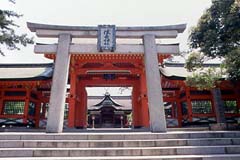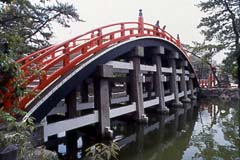 |
 |
Location : Sumiyoshi 2-chome
Access : East of Sumiyoshi Station on the Hankai Tramway
Long revered as enshrining the gods of seafaring, purification and song,
the grand shrine's four wings are built in what is known as the Sumiyoshi
Style. Roofed with cedar bark and featuring a gabled roof and door motif,
the current building was created circa 1810; the unique structure has
been designated a national treasure. There are more than 600 stone lanterns
within the grounds, most of which were donated by merchants from Osaka,
Sakai, and many other areas nationwide. Searches through ancient texts
have helped to confirm that the arched Taikobashi Bridge dates from before
the Kamakura period. Many of the shrine's festivals and ceremonies are
very well known, including the U-no Ha ritual in May, Rice Planting Festival
on June 14, and the Sumiyoshi Festival between July 30 and August 1. The
shrine's grounds, which cover more than 90,000 m2, are home to a number
of important cultural assets, including the stone stage, the south gate,
and the east and west auditoria. The aforementioned Rice Planting Festival,
known for such events as the Rice Planting and Sumiyoshi Dances, was designated
an intangible cultural asset in 1979. |

